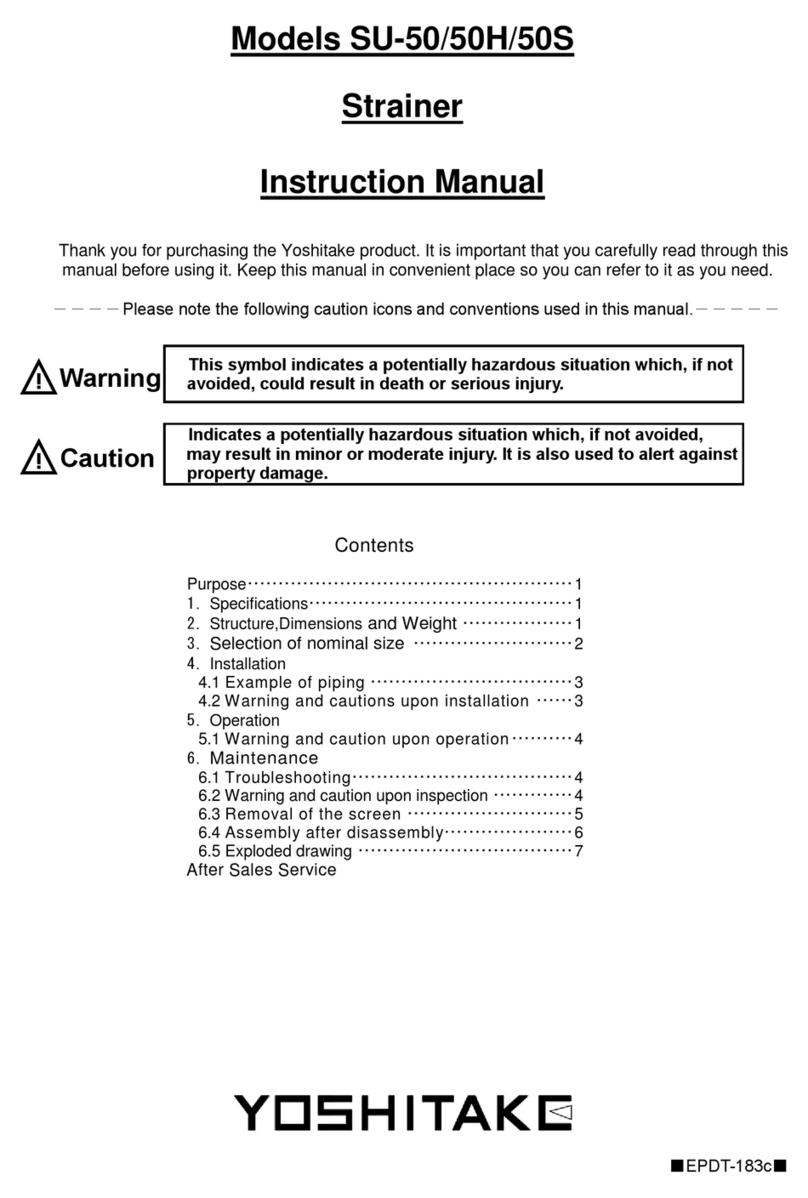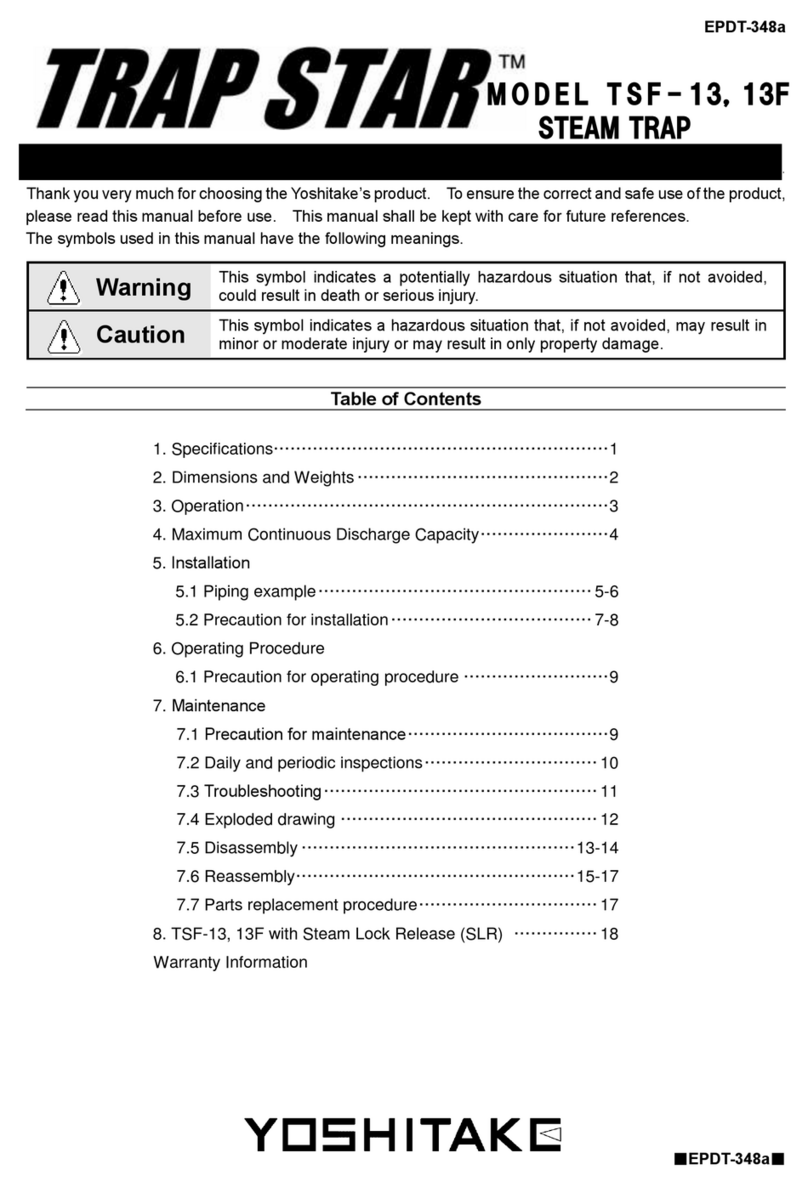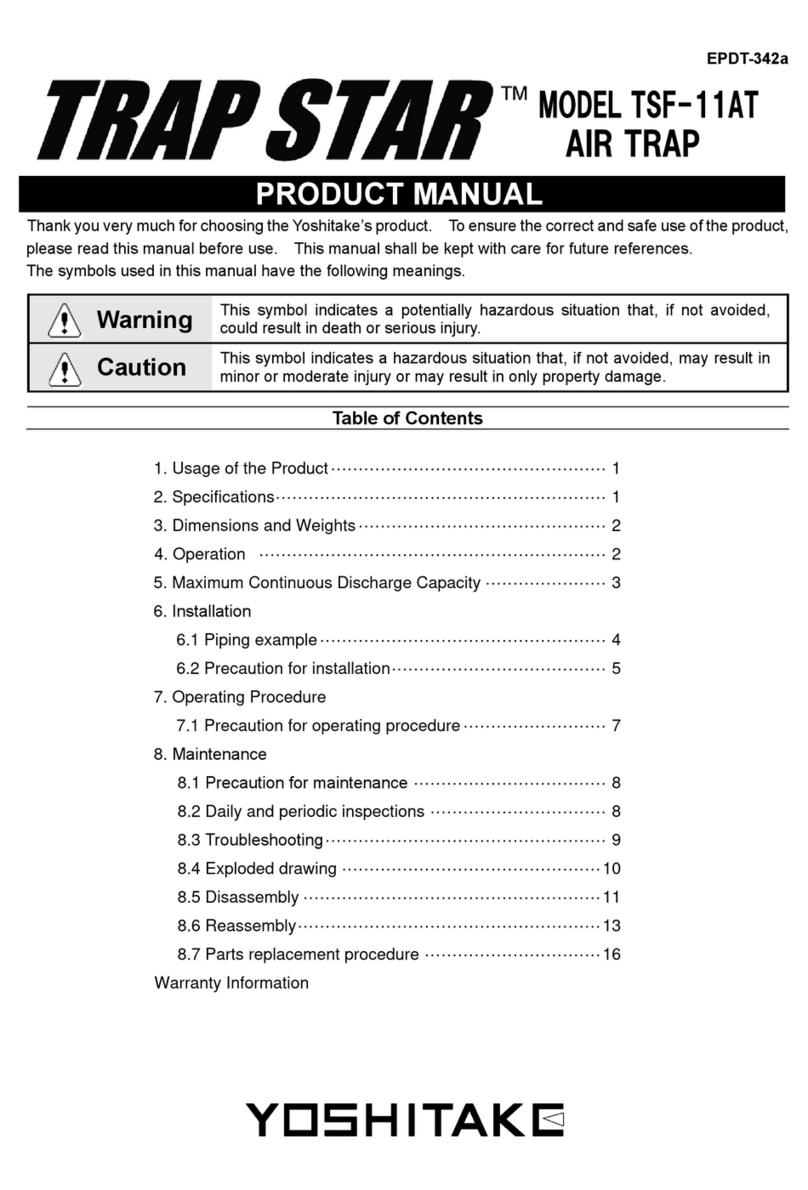Yoshitake TRAP STAR TSF-12 Series User manual

EPDT-307
PRODUCT MANUAL
.
Thank you very much for choosing the Yoshitake’s product. To ensure the correct and safe use of the product,
please read this manual before use. This manual shall be kept with care for future references.
The symbols used in this manual have the following meanings.
Warning
This symbol indicates a potentially hazardous situation that, if not avoided,
could result in death or serious injury.
Caution
This symbol indicates a hazardous situation that, if not avoided, may result in
minor or moderate injury or may result in only property damage.
Table of Contents
1. Specifications···························································· 1
2. Dimensions and Weights············································· 2
3. Operation································································· 2
4. Maximum Continuous Discharge Capacity ······················ 3
5. Installation
5.1 Piping example··················································4-5
5.2 Precaution for installation·····································6-7
6. Operating Procedure
6.1 Precaution for operating procedure·························· 7
7. Maintenance
7.1 Precaution for maintenance ·································7-8
7.2 Daily and periodic inspections ································ 8
7.3 Troubleshooting·················································8-9
7.4 Exploded drawing ················································ 9
7.5 Disassembly················································· 10-11
7.6 Reassembly·················································· 11-14
7.7 Parts replacement procedure ································14
Warranty Information
STEAM TRAP
MODEL TSF-12

1
1. Specifications
Model TSF-12
Nominal size 40A,50A
Application Steam condensate
Working pressure
(Maximum working
differential pressure)
TSF-12-1 : 0.01-0.1 MPa (0.1 MPa)
TSF-12-2 : 0.01-0.2 MPa (0.2 MPa)
TSF-12-5 : 0.01-0.5 MPa (0.5 MPa)
TSF-12-9 : 0.01-0.9 MPa (0.9 MPa)
TSF-12-12 : 0.01-1.2MPa (1.2 MPa)
TSF-12-17 : 0.01-1.7MPa (1.7 MPa)
Max. temperature 230°C
Material
Body Ductile cast iron
Float Stainless steel
Valve,
valve seat
Stainless steel
Connection JIS Rc screwed
NPT screwed
* For installation posture, see 3 of “5.2 Precaution for installation“ .
Caution
1. Depending on application, specification of the product shall be selected. Refer
to Technical material, e.g. Operating instruction, Technical guidebook, and
drawing, and select suitable specification. Regarding technical material like
drawing, contact our sales office.
2. Please confirm that the indications on the product correspond with the
specifications of the ordered product model before use.
* If they are different, do not use the product and contact us.

2
2. Dimensions and Weights
(mm)
Model Nominal
size d LA A1H Weight
(kg)
TSF-12 40A Rc 1 1/2
NPT 1 1/2
200 308 266 228 21.7
50A Rc2 NPT 2 200 361 319 285 24.6
3. Operation
At start-up, since the float④is down, the valve⑦is closed. In this state, air in the system and piping
is discharged out through the air vent⑱which is opened. When condensate flows into the product,
the float④lifts up and opens the valve⑦, and then discharges condensate. Air is continuously
discharged out from the air vent⑱. When steam flows into the product, internal pressure of the air
vent⑱rises by steam temperature, and the air vent⑱closes. According to the amount of condensate
inflow, the float④position moves up and down changing the opening degree of the valve⑦, and thus
condensate is continuously discharged.

3
4. Maximum Continuous Discharge Capacity
1. Discharging capacity of the steam trap differs by working differential pressure, that is, difference
between inlet pressure and outlet pressure (back pressure). In selecting discharge capacity,
consider outlet pressure. If inlet pressure is 0.5 MPa and outlet pressure is 0.2 MPa, discharge
capacity is of working differential pressure of 0.3 MPa.
2. The discharge capacity shown in the charts below is the maximum value. In designing a system, select a
steam trap with a sufficient safety factor (at least twice). That is, for example, if a discharge capacity of 1000
kg/h is required, select a steam trap capable of discharging more than 2000 kg/h (maximum discharge).
Maximum Continuous Discharge Capacity of TSF-12 40A
Maximum Continuous Discharge Capacity of TSF-12 50A
Discharge capacity (kg/h)
Working differential pressure (MPa)
TSF
-
12
-
1
7
TSF
-
12
-
1
TSF
-
12
-
2
TSF
-
12
-
5
TSF
-
12
-
9
TSF
-
12
-
1
2
Discharge capacity (kg/h)
Working differential pressure (MPa)
TSF
-
12
-
1
TSF
-
12
-
2
TSF
-
12
-
5
TSF
-
12
-
9
TSF
-
12
-
12
TSF
-
12
-
1
7

4
Steam main Steam main
Drip leg
Trap
Stop
valve Trap
5. Installation
5.1 Piping example
Description
Correct
Incorrect
If the product is installed close
to a regulating valve, make
sure to install the product at
the inlet side of the regulating
valve.
To discharge condensate from
the steam main, be sure to
install the product on piping
taken from the lower part of
drip leg.
Install the product below a
device which generates
condensate.
Regulating
valve Regulating
valve
Drip
leg
Stop
valve
Stop
valve
Pressure
gauge Pressure
gauge
Stop
valve
Stop
valve
Check
valve
Sight
grass
Strainer
TSF-12
Steam trap
Stop
valve

5
Low
pressure
High pressure
Low pressure
High pressure
Stop
valve
Stop
valve
By-pass valve
Stop
valve
Trap Trap
Stop
valve
By-pass valve
Description
Correct
Incorrect
Install the products for each
device independently.
The diameter of collecting pipe
shall be more than summation
of sectional areas of discharge
pipes.
In addition, install check valves
for back flow prevention.
For condensate recovery,
connect the discharge pipe to
the upper part of collecting
pipe.
For traps of different pressure
lines, install collecting pipes
individually for each pressure.
In addition, install check valves
for back flow prevention.
* Re-evaporated steam in high
pressure line increases the back
pressure of low pressure trap.
End portion of discharge pipe
shall be off the water surface in
the pit.
* If the discharge pipe is in contact
with the water, it absorbs dirty
water in the pit and causes
malfunction of the product.
Provide a by-pass line around
the product, and install stop
valves at the outlet side of the
product.

6
5.2 Precaution for installation Warning
1. In order to discharge condensate to the atmosphere, lead the outlet to a safe place where there is no
possibility of physical damage even if condensate blows out.
* There are risks of scalding or injury when the condensate blows out.
Caution
1. Before connecting the product to piping, remove foreign substances and scale from the piping.
* Failure to follow this notice may prevent the product from functioning properly.
* To plumb the product, be careful to keep seal materials from entering into the product.
2. To install the product, check the direction of the product so that the fluid flowing and the arrow mark on
the product are in the same direction.
* Setting the product in wrong directions prevents it from functioning properly.
3. Check installation posture. Do not tilt the product during use.
* Wrong posture hampers proper operation.
OK NG
TOP
* Allowable tilt from horizontal line is within ±10°.
* Support the product cover when it is necessary.
4. Make sure to support the piping immovably.
* If an excessive piping stress is applied, there are cases when the product will not open or close.
5. Do not disassemble the product unless it is necessary.
*Unnecessary disassembly may prevent the product from functioning properly.
6.
Secure enough space for maintenance, inspections and repair as shown below.
* Failure to follow this notice prevents maintenance, inspection and repair.
UP
DOWN
UP
DOWN
40A:320mm or more
50A:370mm or more
Cover
Body

7
7.
Slope the piping and place the product at as a low position as possible in order to make condensate
flow into the product by its own weight.
8. To install the product in a main steam pipe, provide a drip leg at the inlet side of the product.
9.
Install a strainer (mesh size of 80 or more is recommended) at the inlet side of the product.
10. Install the product in a way it is not subjected to the shock of water hammer. Do not install a quick
operating valve before and/or after the product.
* Failure to follow this notice may result in malfunction due to damage to the float or air vent, or may result in
scalds or injury due to blow off when the product is subjected to an excessive shock and damaged.
11.
Install a bypass line.
* The system has to stop operation while inspection and maintenance of the product if the bypass line is not
installed.
6. Operating Procedure
6.1 Precaution for operating procedure Warning
1. Before leading fluid, make sure that the product is securely connected to piping and that there is no
loose.
* There are risks of scalding or injury when the steam or condensate blows out.
2. Do not touch the product with bare hands while the product operates.
* There are risks of scalding.
3. Do not stand in front of the outlet opening of the product while the product operates.
* There are risks of scalding or injury due to blow off.
Caution
1. Slowly open each stop valve to prevent water hammer.
* When opening stop valves quickly, there are cases when the equipment will be damaged due to
hunting or water hammer.
7. Maintenance
7.1 Precaution for maintenance Warning
1. Do not touch the product with bare hands.
* There are risks of scalding.
2. Completely discharge internal pressure of the product, piping and equipment, and cool down the
product prior to disassembly or maintenance.
* There are risks of scalding or injury due to residual pressure.
Caution
1. Conduct daily inspection in order to maintain the optimal performance of the product.
* Failure to follow this notice may prevent the product from functioning properly.
* See “7.3Troubleshooting” on Page 8 and 9 if trouble is observed.
2. After leaving the product not operated for a long period, perform inspection before start-up of
operation.
* Failure to follow this notice may cause malfunction due to rust inside of the product and piping.
3. Put a container under the product at disassembly since condensate may flow out.
* Failure to follow this notice may result in making the surroundings dirty.
4. Be careful not to drop the parts at the time of disassembly. The disassembled parts should be placed
on soft cloth in order to avoid scratches and damage.
* Damage on the parts may cause malfunction and affect the optimal performance.

8
Caution
5. To assemble, connect all the parts securely and tighten the bolts uniformly in diagonal order.
* Failure to follow this notice may cause malfunction or outside leakage.
6. When repairing, do not use the parts other than the dedicated parts manufactured by Yoshitake. Do
not modify the product.
* Failure to follow this notice may cause damage to the product, or may result in scalds or injury due to
blow-off or malfunction.
7. In case of problems due to foreign substances or scale, the product needs repair or part replacement.
Please contact us for details.
(Please note that any repair due to foreign substances or scale in the product is subject to a charge
even during the warranty period.)
7.2 Daily and periodic inspections
Conduct daily and periodic inspections in order to maintain the optimal performance of the product.
See ”7.3 Troubleshooting” on Page 8 and 9 for the remedies if trouble is observed.
Daily inspection (once a day)
Conduct daily inspection during operation of the product.
Items
Standards for Inspection
Discharge condition
of condensate Condensate is discharged smoothly.
Outside leakage No outside leakage of condensate or steam.
Periodic inspection (once a year)
Conduct disassembly inspection periodically.
Items
Standards for Inspection
Seat surfaces of the
valve and valve seat
No scratch, abrasion, or foreign substances on seat surfaces.
Shape of float (P) No deformation or damage on the float (P)
7.3 Troubleshooting
Trouble Cause Remedy
Condensate is not
discharged. 1. Blockage of foreign substances
in the valve seat. 1. Disassemble and clean it.
2. Float (P) is broken 2. Change it into new one.
3. Breakage as a result of
abnormal pressure rising due to
freezing or water hammer, etc.
3. Replace the product with new one.
4. Steam locking. 4. Change the piping system layout.
5. Product is in wrong posture. 5. Adjust direction of the mark “TOP”
to upward.
*See Caution No. 3,“5.2 Precaution for
Installation” on Page 6.

9
Trouble Cause Remedy
Continuous
blowout. 1. Foreign substances stuck on
valve, valve seat or air vent (P). 1. Disassemble and clean them.
2. Abrasion or scratches on the
valve, valve seat, air vent (P) or
air vent valve seat.
2. Replace the parts.
3. Insufficient capacity of the
product. 3. Replace the product with another
model of sufficient capacity.
4. Product is in wrong position. 4. Adjust direction of the mark “TOP”
to upward.
*See Caution No. 3,“5.2 Precaution for
Installation” on Page 6.
Steam leakage. 1. Leakage due to loosening of the
bolt. 1. Replace the cover gasket with new
one, and retighten the bolt.
*See Procedure 6, “7.6 Reassembly” on
Page 14.
2. Leakage as a result of abnormal
pressure rising due to freezing
or water hammer, etc.
2. Replace the product with new one.
7.4 Exploded drawing
*The parts shown in the rectangle boxes are available as consumable supply.
* Float (P) and float holder can be removed together (can not be disassembled).
Air Vent
Cover Gasket
Float Holder
Air Vent
Valve Seat
Air Vent Gasket
Air Vent
Cover
Air Vent Spacer
Valve Seat
Air Vent (P)
Air Vent Holder
Cover
Spacer
Float(P)Plate
Body

10
7.5 Disassembly
Tools to be used
Name of tool Size (Nominal size)
Spanner,Ring wrench 13 , 32 mm
Socket wrench 19 , 39 mm
Radio pliers
[Procedure 1] Remove the hexagon bolts and nuts that fixing the body with a spanner,
wrench, etc (width across flat: 32mm). Then remove the body and gasket
from the cover.
[Procedure 2] Remove the air vent holder with radio pliers.
[Procedure 3] Remove air vent and spacer by hand.
[Procedure 4] Remove the air vent valve seat with socket wrench (width across flat: 19
mm). Be careful as the valve seat has a gasket.

11
[Procedure 5] Remove the hexagon bolt on the upper side of the plate and the bolt on the
inlet side of the float holder with spanner, ring wrench, etc (width across flat:
13mm). Then remove the plate.
[Procedure 6] Remove the hexagon bolt on the outlet side of the float holder with spanner, ring
wrench, etc (width across flat: 13mm). Then the float (P) and float holder can be
removed. The valve is attached to the float (P).
[Procedure 7] Remove the valve seat with socket wrench (width across flat: 39 mm).
7.6 Reassembly
Tools to be used
Name of tool Size (Nominal size)
Torque Wrench * Tightenable with torque of 200 N・m
Width across flat: 32 mm
Torque Wrench * Tightenable with torque of 30 N・m, Open-head type
Width across flat: 13 mm
Torque Wrench * Tightenable with torque of 50 N・m
Width across flat: 19 mm
Torque Wrench * Tightenable with torque of 230 N・m
Width across flat: 39 mm
Spanner,Ring wrench 13 mm
Radio pliers

12
[Procedure 1] Tighten the valve seat with a torque of 230 N・m using torque wrench(width
across flat: 39 mm).
[Procedure 2] Assemble the air vent valve seat, air vent cover and air vent gasket, and
attach them to the cover by tightening with 50 N・m torque using torque
wrench (width across flat: 19 mm). At that time, adjust the air vent cover to
make its rectangular holes come on both sides (not top and down), as shown
in the picture.
[Procedure 3] Put the spacer and attach the air vent in the air vent cover. Please pay
attention to the direction of the air vent.
OK NG
[Procedure 4] Air vent holder can be assembled by hand.
Assembled Air vent(P)

13
[Procedure 5] Temporarily tighten the hexagon bolt at the outlet side of the float holder
with a spanner, ring wrench, etc (width across flat: 13 mm).
Next, align the screw hole on the inlet side of the float holder and the bottom hole
of the plate, and temporarily tighten the hexagon bolt with a spanner, ring wrench,
etc (width across flat: 13 mm). The plate will be on the upper side of the float
holder as shown in the picture.
Then, align the spacer with the plate top hole and temporarily tighten the bolt.
After temporarily tightening the three bolts, tighten them with torque of 30 N・m
with a torque wrench (width across flat: 13 mm).

14
[Procedure 6] Put a new gasket on the cover and tighten the hexagon bolts and nuts fixing
the body with 200 N・m torque using torque wrench (width across flat: 32 mm).
7.7 Parts replacement procedure
Part name Disassembly
(See 7.5.) Reassembly
(See 7.6.)
Cover gasket Procedure 1 Procedures 6
Float (P)
Float Holder Assembly Procedures 1 & 5 to 6 Procedures 5 to 6
Valve Seat Procedures 1 & 5 to 7 Procedures 1 & 5 to 6
Air vent (P) ※Procedures 1 to 4 Procedures 2 to 4 & 6
※Air vent(P) refers to air vent holder, air vent, air vent spacer, air vent valve seat, air vent cover
and air vent gasket.
This manual suits for next models
6
Table of contents
Other Yoshitake Industrial Equipment manuals
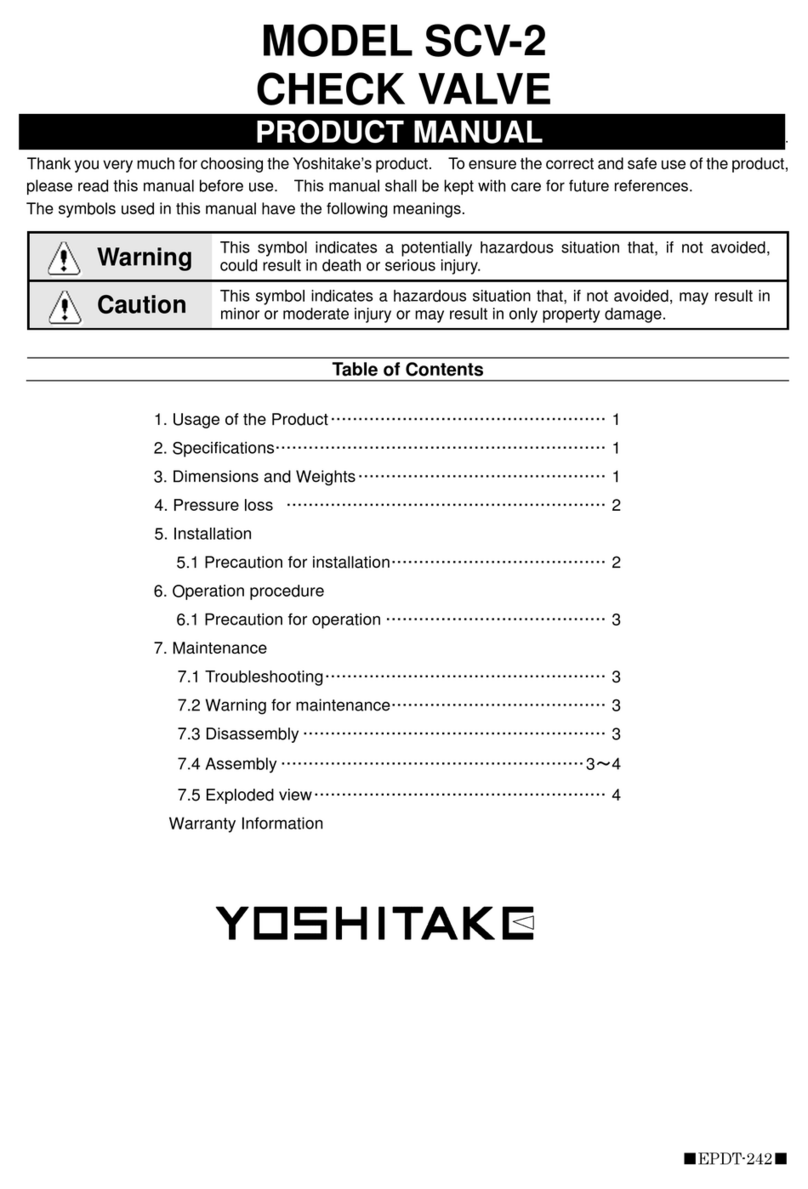
Yoshitake
Yoshitake SCV-2 User manual
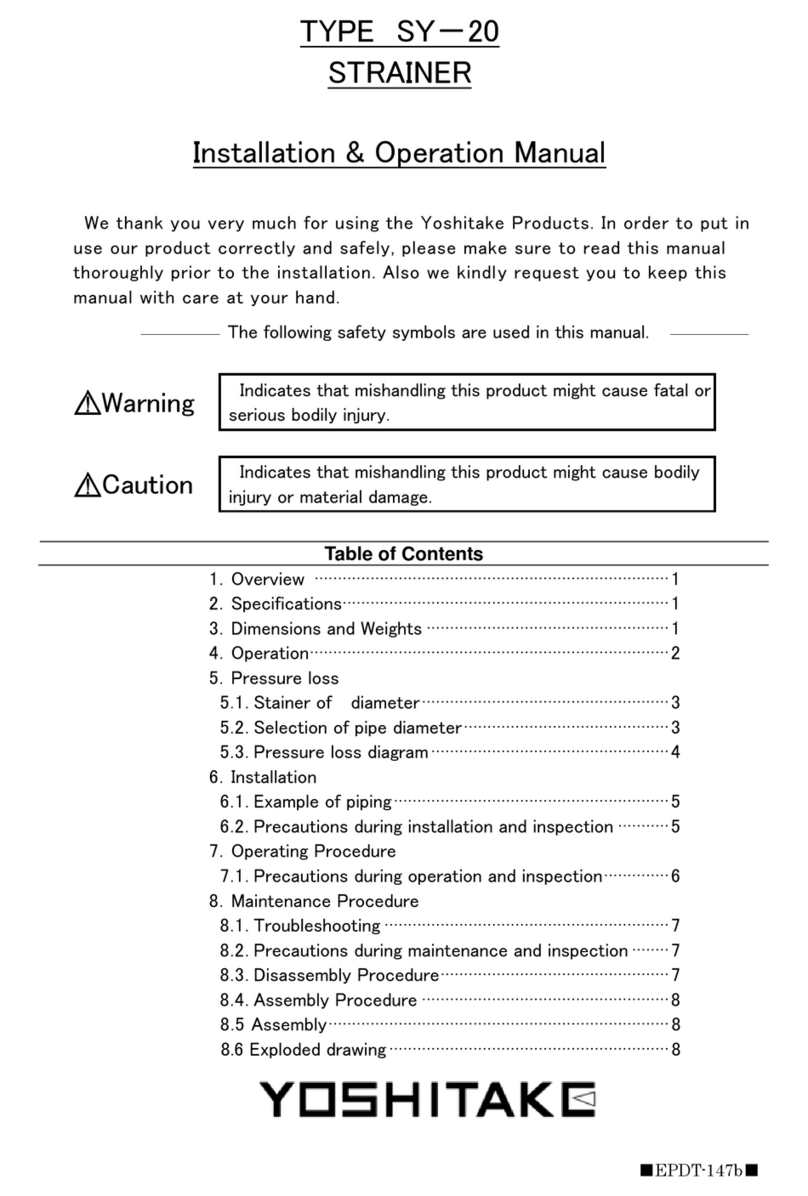
Yoshitake
Yoshitake SY-20-10 User manual

Yoshitake
Yoshitake SY-8 User manual
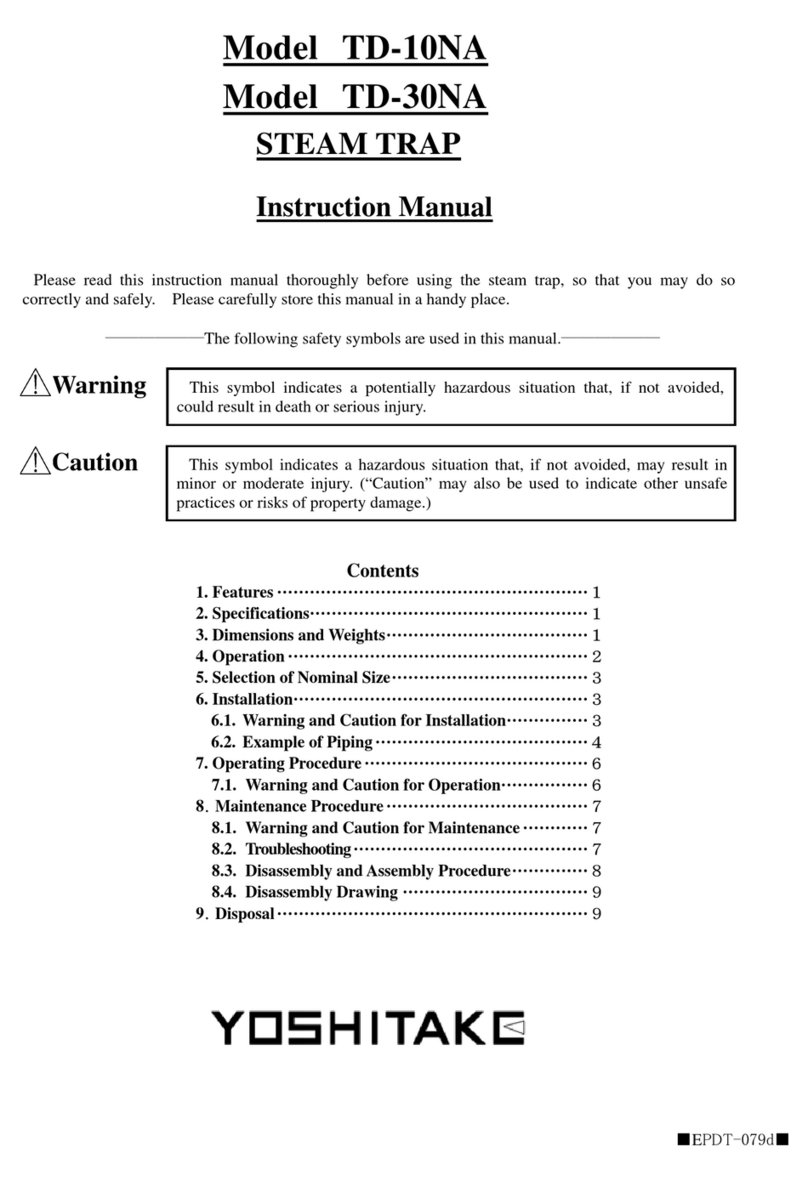
Yoshitake
Yoshitake TD-10NA User manual
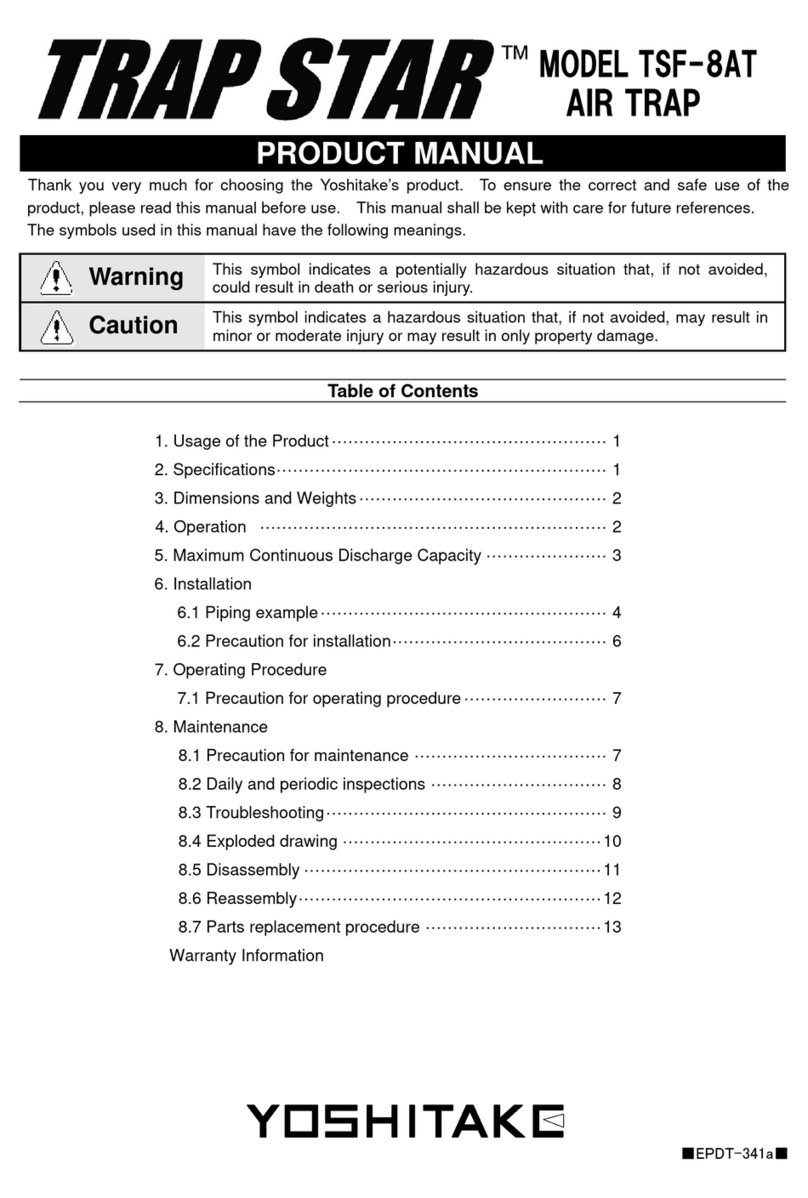
Yoshitake
Yoshitake Trap Star TSF-8AT User manual
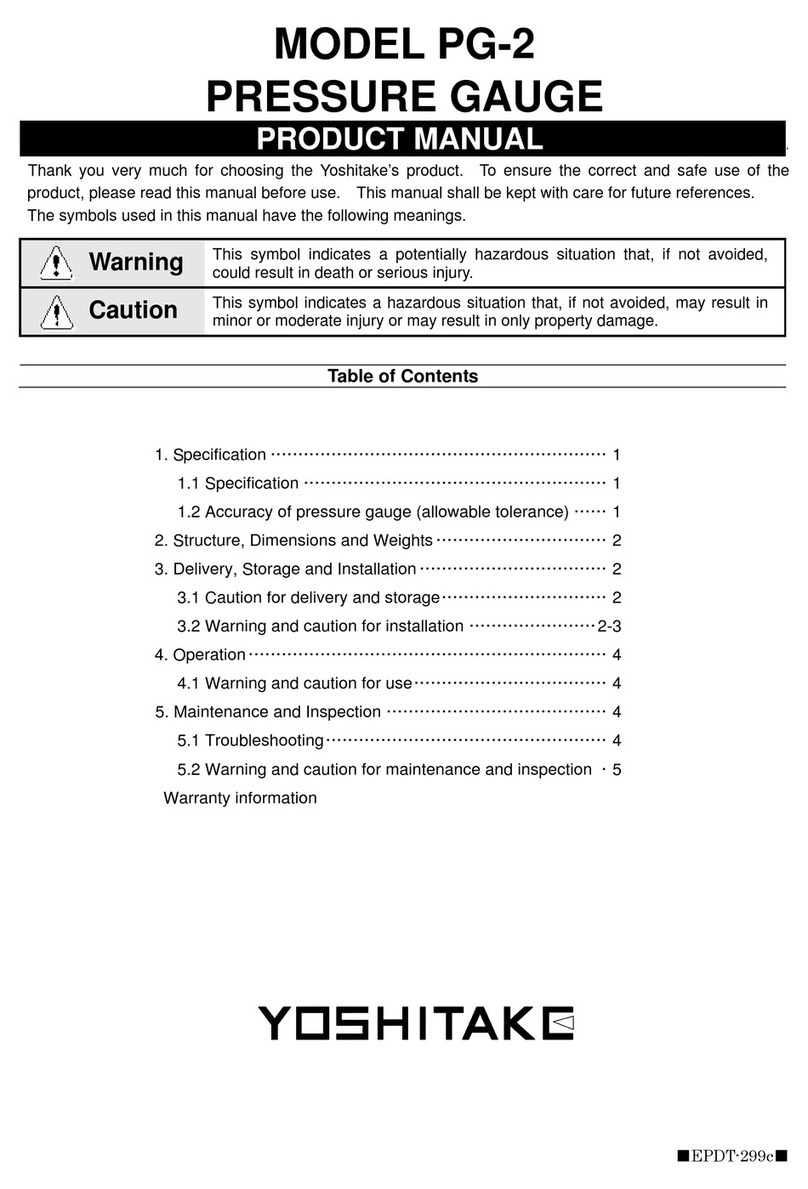
Yoshitake
Yoshitake PG-2 User manual
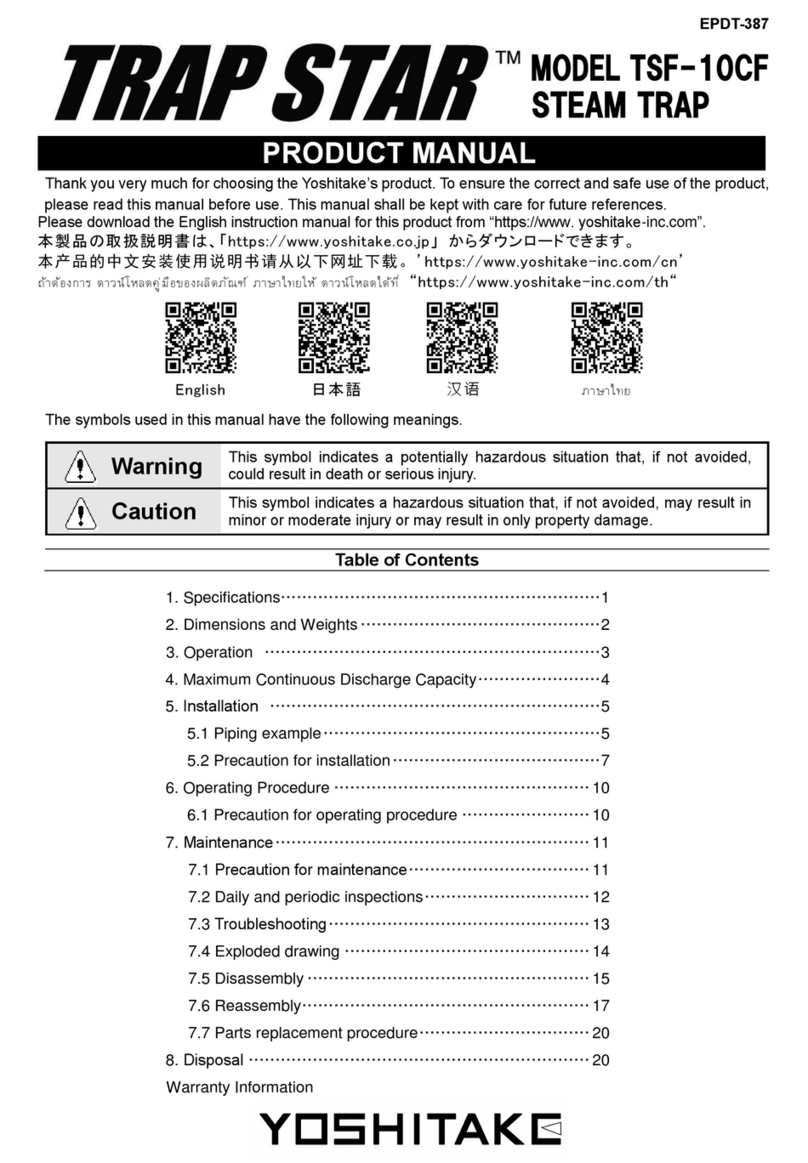
Yoshitake
Yoshitake TRAP STAR TSF-10CF User manual
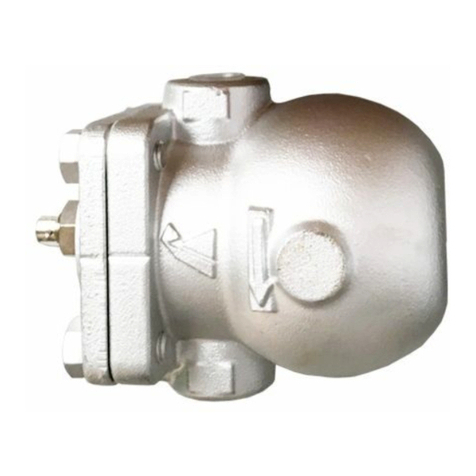
Yoshitake
Yoshitake TRAP STAR TSF-10 User manual

Yoshitake
Yoshitake TRAP STAR TSF-8 User manual
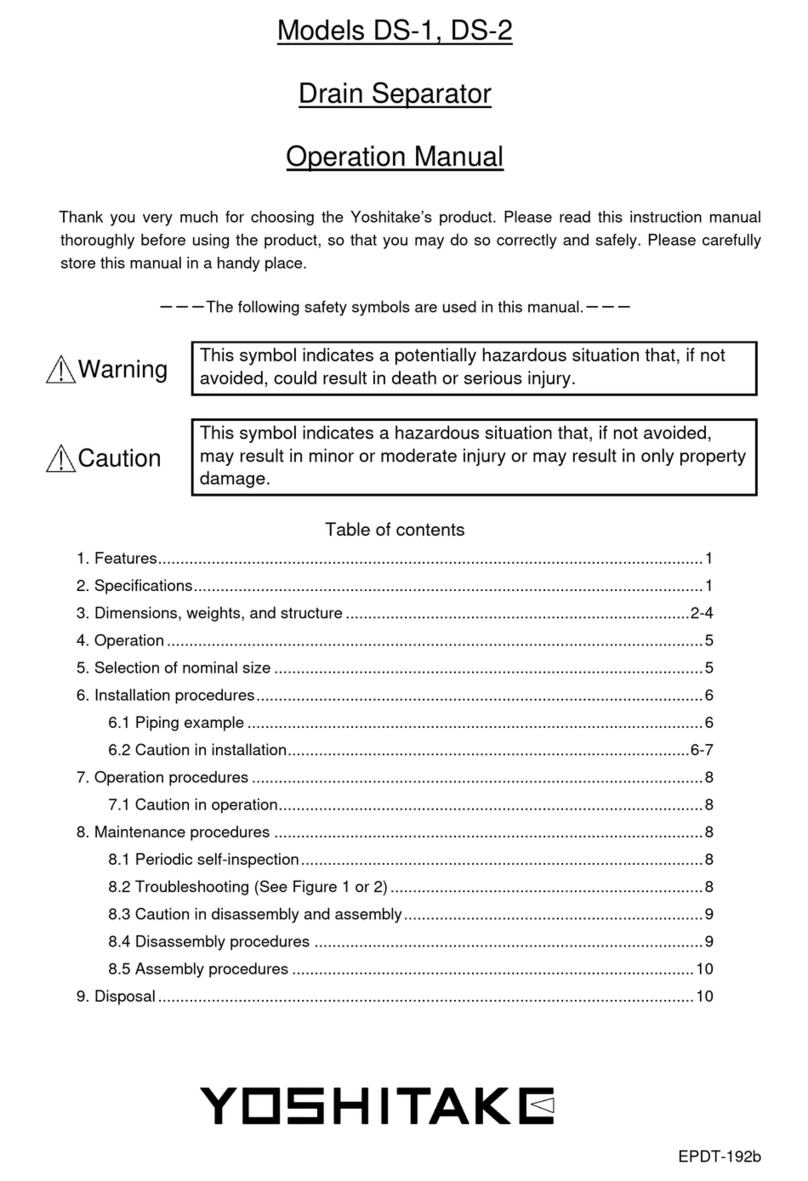
Yoshitake
Yoshitake DS-1 User manual

